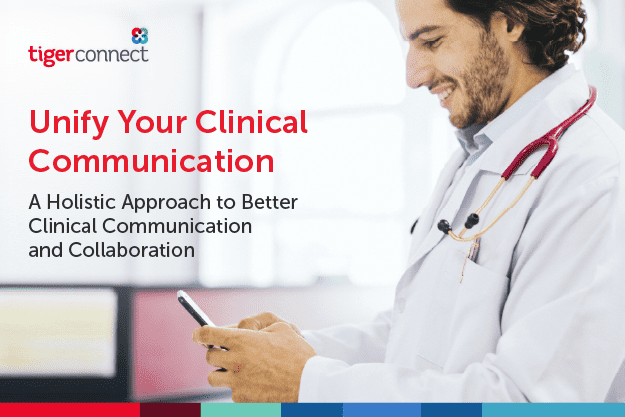Home / Blog /
Improving Patient Safety Through Unified Clinical Collaboration

Improving Patient Safety Through Unified Clinical Collaboration
Minimizing clinical errors and maximizing patient care – through the power of clinical collaboration.
The healthcare industry is being tested like never before. Faced with an unprecedented number of patients, providers are challenged with too many cases and not enough time. Nurses, physicians, and other healthcare professionals are often overworked, which can impact clinical workflows and put patient safety at risk. Speeding clinical workflows is not just beneficial for patient outcomes, it can also help improve issues such as response times and operational efficiency.
A recent story by NBC News reports that nearly 1 in 4 patients admitted to U.S. hospitals experienced adverse events. Approximately 7 percent of those events were preventable. Despite healthcare providers working tirelessly to provide quality patient care, medical errors do occur. A key strategy to improve patient safety and prevent errors is to streamline communication with a modern clinical communication and collaboration (CC&C) platform.
Unify Your Clinical Communication
Learn how a dedicated clinical communication and collaboration platform can improve clinical workflows.
|
 |
How Communication Impacts Patient Safety
Given the increased number of cases and advanced treatments providers encounter on a daily basis, effective communication between care teams is paramount to patient care. Unfortunately, streamlining communication and collaboration across primary care providers, specialists, surgeons, and hospitals is challenging. Hospitals and health systems often leverage various disparate solutions to communicate. Whether it’s embedded messaging within an EHR system or back-and-forth phone calls – most of these channels rarely support an efficient clinical workflow. This creates a range of cumbersome steps to get the right information securely and safely into the hands of the right person on the care team.
These silos create communication disconnects in clinical workflows and slow down access to critical patient data. Patient care is significantly delayed while providers are looking for the contact information for the right care team member or consulting schedules to find the on-call specialist. And it’s not just one moment in time. These delays are happening in real-time across thousands of patients in hospitals worldwide. Doctors are overburdened, time is wasted, errors occur, and patient care suffers. It’s a no-win situation for clinical care teams.
The Power of Streamlined Clinical Communication
Solutions like clinical communication and collaboration platforms are designed to address these challenges by enabling healthcare providers to easily share patient information, such as medical records, test results, and treatment plans, in real time. This improves communication and coordination among providers, leading to faster and more efficient workflows, reduced length of stay, reduced readmissions, and better patient outcomes.
In a critical situation where time is of the essence, a CC&C platform can make a significant difference in clinical workflows. For example, a typical stroke patient loses 1.9 million neurons and 14 billion synapses for every minute that goes by while they’re waiting to be treated. CC&C platforms enable real-time communication between stroke care team members, helping to accelerate the workflow and ensuring that the patient gets life-saving treatment faster.
By enhancing care team collaboration, CC&C platforms allow healthcare providers to dramatically accelerate clinical workflows and improve patient outcomes.
Real-Time Monitoring and Alerts
In addition to care team communication, alarm fatigue is another factor that can impact patient safety. When healthcare providers are overwhelmed by patient alerts and alarms, many of which are non-actionable, providers can become desensitized and miss critical alarms. Integrating your healthcare organization’s CC&C platform with alarm management can help reduce alarm fatigue by filtering alerts and alarms, intelligently routing notifications to the right person, and providing contextual information about different alert types.
Context-rich notifications are routed to the appropriate person, reducing unnecessary interruptions, filtering out false alarms, and enabling physicians and nurses to focus on higher-acuity patient care.
Improving Patient Safety with TigerConnect
While provider error and inefficient communication are some of the top causes of patient safety risks, there is a better way. The TigerConnect Clinical Collaboration Platform enables healthcare providers to communicate and collaborate efficiently, leading to faster clinical workflows, more effective treatment plans, and ultimately better patient outcomes. By integrating the TigerConnect Clinical Collaboration Platform with a clinical decision support tool, Baylor St Luke’s Medical Center reduced its door-to-needle time by 50%. The health system has dramatically improved patient outcomes with an estimated 75 stroke lives saved per year.
With better care team collaboration and speedier response times, there is less room for errors and patient risks. Additionally, TigerConnect Alarm Management & Event Notification is a seamless solution that integrates with nurse call systems, monitors, EHR systems to ensure context-rich notifications can be routed to the appropriate caregiver.
Interested in taking the next step? Now’s the time to download our eBook, “Unify Your Clinical Communication” to learn more.
Will O'Connor M.D., CMIO at TigerConnect
Will O’Connor, M.D. is the Chief Medical Information Officer at TigerConnect. As a physician executive with more than 20 years of healthcare experience, Will is a passionate advocate for rapid advancement across the healthcare industry.
Tags: Clinical Communication and Collaboration, Patient Safety, Clinical Collaboration, Clinical Communication








